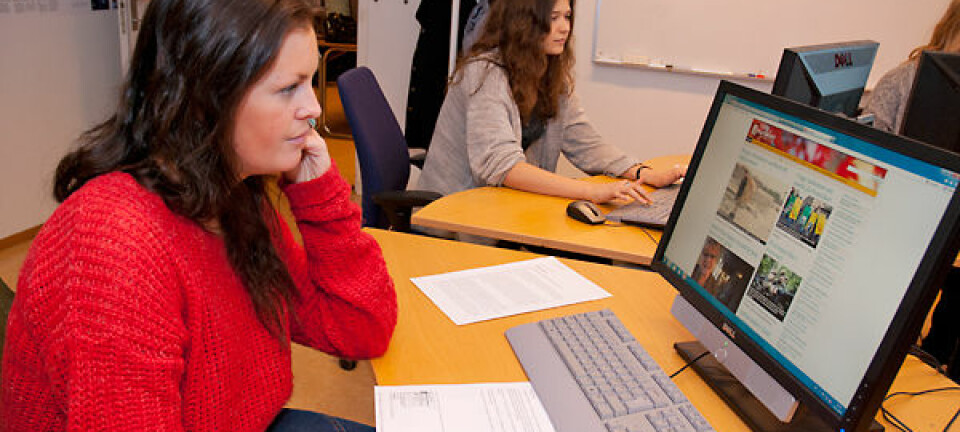An article from University of Tromsø – The Arctic University of Norway

Worthwhile word-of-mouth on social media
Social media have brought the power of word-of-mouth to a large audience. That means your opinion can have great influence.
Denne artikkelen er over ti år gammel og kan inneholde utdatert informasjon.
Gatherings of lots of people are attractive to companies, which inevitably are interested in the marketing and advertising possibilities offered by big crowds.
In recent years, people have gathered in ever-larger flocks to social media on the Internet, at online communities such as Facebook. Worldwide, there are more than 900 million members of the Facebook community, which makes it easy to share your thoughts and ideas with others.
In particular, you can talk about products and services you will either recommend or tell people to avoid. This kind of conversation is called “word-of-mouth”, and has been around a long time.
What is new now is that the Internet and social media have made word-of-mouth discussions accessible to a much larger audience. This can have a major impact for two reasons:

- Potential customers can read what you write, and can change their behaviour or attitude towards a product or service.
- Businesses can also use word-of-mouth conversations to improve their products.
Before, these word-of-mouth conversations occurred without the company being able to know what was said, but word-of-mouth conversations conducted using social media are openly accessible, in the public domain. Smart companies know this and can gain valuable information from customers’ reactions to their product or service.
A new kind of marketing
Another consequence of word-of-mouth moving into the public domain is that the conversations spread much faster than before. This rapid spread of information is often called viral, which means that information moves from person to person at high speed.
For those involved in marketing on the Internet, the ripple effect from a word-of-mouth commentary is of great interest -- if their product is described positively. In fact, this approach can be an effective way to market a new product.
“This is a completely new way of thinking about marketing. It’s a change that is here to stay. Marketers must change their mind set, and find out how they can have a dialogue with customers and get them to talk about a product,” says Anders Wien, an assistant professor at the Tromsø University Business School, who is writing his doctorate on word-of-mouth.
He is interested in what makes people talk about goods and services, and what this means for corporate marketing.
Other consumers more trustworthy
Consumers have always trusted other users of a product more than the company that makes it. With social media, consumers around the world can help each other by sharing their experiences. The website Tripadvisor.com is one such example. It works like a travel guide, where people share hotel reviews and other useful tips.
“We trust other consumers, because they have no interest in deceiving us. They are in the same boat as we are, and we have to help each other. But it can be smart to consider why people might be motivated to engage in word-of-mouth recommendations. They may be excited about a product, but it can also be important for them to be the first to talk about a new product. They may want to be seen as trend-setters as a way to enhance their social status,” Wien says.
But what if a company uses this to their advantage, by pretending to be a consumer and talking nicely about their product – and thus misleads others?
“A few years ago, competing hotels published negative reviews of each other on TripAdvisor. But if consumers find out that your company is engaged in this sort of activity, it can destroy your credibility. Most have stopped trying these kinds of tricks. Openness and honesty last the longest in social media,” Wien says.
More power to consumers
Social media marketing differs significantly from marketing on the Internet at large. Dialogue is the key. Consumers tend to filter out regular advertising on the Internet, but they may find it more useful when businesses share information through dialogue.
Dialogue gives consumers more influence and power: it means that more people hear them. But since consumers are in the driver's seat, sometimes the conversation can go in the wrong direction for the businesses involved.
McDonald’s, the giant fast-food chain, experienced this when the company asked customers to write about their best restaurant experiences and post them on Twitter.
They hoped they would get a lot of positive stories, but customers shared not only their best moments – but also their worst. One wrote that he lost 22 kilograms after he stopped working for the hamburger chain and thus also stopped eating the food there.
Another wrote that he found a fingernail in his Big Mac burger. And so it continued until the hamburger chain stopped the conversation.
When consumers spread negative word-of-mouth stories that are read by many people, it can destroy your company's reputation at worst. It rarely happens, but companies need to learn from negative word-of-mouth, says Wien.
“Companies should look at word-of-mouth as a source of information to enhance their products. Many businesses have begun to take this seriously, but most have not realized the potential yet. It can be huge, but it also depends on the product, of course,” Wien says.

































